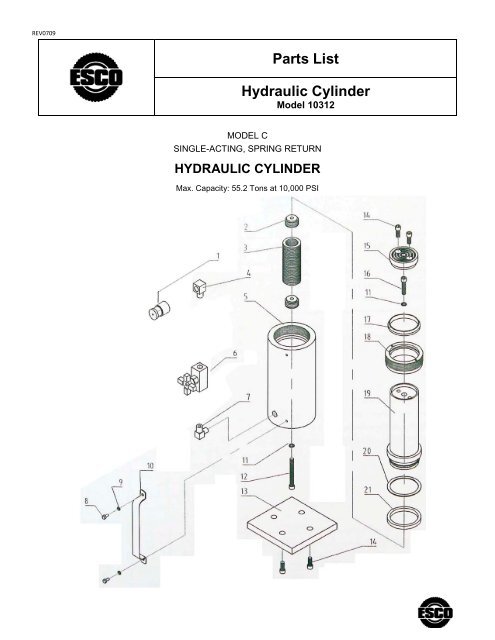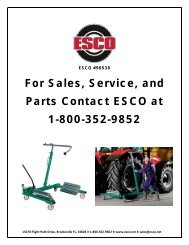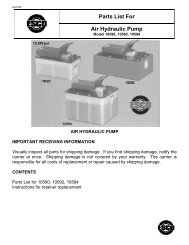Create successful ePaper yourself
Turn your PDF publications into a flip-book with our unique Google optimized e-Paper software.
WARNINGBE SURE SETUP IS STABLE BEFORE LIFTING LOAD.– The cylinder should be placed on a flat surface that can supportthe load. Where applicable, use a cylinder base for addedstability. Do not weld or otherwise modify the cylinder toattach a base or other support.– Avoid situations where loads are not directly centered on thecylinder plunger. Off-center loads produce considerablestrain on cylinders and plungers. In addition, the load may slipor fall, causing potentially dangerous results.– Distribute the load evenly across the entire saddle surface. Tiltsaddles are available to reduce offset loading (except 100ton models). Always use a saddle to protect the plungerwhen threaded attachments are not used.WARNINGUSE ONLY RIGID PIECES TO HOLD LOADS. Carefullyselect steel or wood blocks that are capable of supporting theload. Never use a hydraulic cylinder as a shim or spacer in anylifting or pressing application.WARNINGONLY USE HYDRAULIC CYLINDER IN ACOUPLED SYSTEM.Never use a cylinder with unconnected couplers. If the cylinderbecomes extremely overloaded, the coupler check ball and/orhydraulic oil may shoot out of the cylinder causing severepersonal injury.2
CAUTIONAVOID DAMAGING HYDRAULIC HOSE.– Avoid sharp bends and kinks when routing hydraulic hoses.Using a bent or kinked hose will cause severe back-pressure.Also, sharp bends and kinks will internally damage the hoseleading to premature failure.– Do not drop heavy objects on hose. A sharp impact maycause internal damage to hose wire strands. Applyingpressure to a damaged hose may cause it to rupture.– Do not use the hydraulic hose to carry a hydraulic component(i.e. pumps, cylinders and valves).CAUTIONKEEP HYDRAULIC EQUIPMENT AWAY FROMFLAMES AND HEAT.Excessive heat will soften packings and seals, resulting influid leaks. Heat also weakens hose materials and packings.For optimum performance DO NOT expose equipment totemperatures of 150 o F (65 o C) or higher. Protect hoses andcylinders from weld spatter.3
INSTALLATION1. Make hydraulic connections. Use a pump with a releasevalve or a 3-way valve and one hose for single-actingcylinders (1). Use a pump with a 4-way valve and twohoses for double-acting cylinders (2).IMPORTANT: Double-acting cylinders must have bothcouplers connected.Fully hand-tighten all couplers. Loose coupler connections will block the flow ofoil between the pump and the cylinder.2. Remove air from the cylinder as shown below.Single-acting cylinders: Position the cylinder so that the plunger is pointed down andthe cylinder lower than the pump. Fully extend and retract the cylinder 2 or 3 times.Double-acting cylinders: Lay the cylinder on its side and have the couplersfacing up. Fully extend and retract the cylinder 2 or 3 times.NOTE: Collar threads are rated for the full capacity of the cylinder when fullyengaged in attachments.NOTE: The use of cylinder attachments or extensions reduces the cylinder capacity byat least 50%.4
OPERATIONWARNINGDO NOT HANDLE PRESSURIZED HOSES. Escaping oilunder pressure can penetrate the skin,causing serious injury. If oil is injected under the skin, see adoctor immediately.Operate the hydraulic pump to advance and retract the cylinder.Some single-acting cylinders are spring-return, others are load return. The speed ofretraction is affected by the length of the hose and other restrictions in the line. Doubleactingcylinders are powered in both directions by the pump.The cylinder stop ring is designed to take the full load. However, to reduce cylinderwear, use less than full stroke when possible.MAINTENANCE1. Use dust caps when cylinders are disconnected from the hose. Keep entirecylinder clean to prolong cylinder life.2. Store cylinders up-right to prevent seal distortion.5
TROUBLE SHOOTINGThese cylinders should be repaired only by Authorized ESCO Technical ServiceCenters. Single-acting cylinders are spring loaded and require special disassemblytechniques to prevent personal injury.PROBLEM<strong>Cylinder</strong> will not advance.<strong>Cylinder</strong> advances part way.<strong>Cylinder</strong> advances in spurts.<strong>Cylinder</strong> advances slower than normal.<strong>Cylinder</strong> advances but will not hold.<strong>Cylinder</strong> leaks oil.<strong>Cylinder</strong> will not retract or retracts slower than normal.Oil leaking from external relief valve.POSSIBLE CAUSESPump release valve open.Coupler not fully tightened.Oil level in pump is low.Pump malfunctioning.Load is too heavy for cylinder.Oil level in pump is low.Coupler not fully tightened.<strong>Cylinder</strong> plunger binding.Air in hydraulic system.<strong>Cylinder</strong> plunger binding.Leaking connection.Coupler not fully tightened.Pump malfunctioning.<strong>Cylinder</strong> seals leaking.Pump malfunctioning.Leaking connection.Incorrect system set-up.Worn or damaged seals.Internal cylinder damage.Loose connection.Pump release valve is closed.Coupler not fully tightened.Pump reservoir over-filled.Narrow hose restricting flow.Broken or weak retraction spring.<strong>Cylinder</strong> damaged internally.Coupler not fully tightened.Restriction in return line.6
















